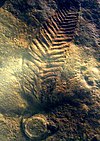| Rangeomorph Temporal range: Possibly one of the last representatives of the Ediacaran biota.
| |
|---|---|

| |
| Charnia masoni, a rangeomorph | |
| Scientific classification | |
| Domain: | Eukaryota |
| Kingdom: | Animalia |
| Phylum: | †Petalonamae |
| Clade: | †Rangeomorpha Hofmann et al., 2008 |
| Subtaxa | |
| Synonyms | |
| |
The rangeomorphs are a form taxon of frondose Ediacaran fossils that are united by a similarity to Rangea. Some researchers, such as Pflug and Narbonne, suggest that a natural taxon Rangeomorpha may include all similar-looking fossils. Rangeomorphs appear to have had an effective reproductive strategy, based on analysis of the distribution pattern of Fractofusus misrai, which consisted of sending out a waterborne asexual propagule to a distant area, and then spreading rapidly from there, just as plants today spread by stolons or runners.[1][2]
Rangeomorphs are a key part of the Ediacaran biota, which survived about 30 million years, until the base of the Cambrian, which was 538.8 million years ago. They were especially abundant in the early Ediacaran Mistaken Point assemblage found in Newfoundland.[3]
Body plan[edit]
Rangeomorphs consist of branching "frond" elements, each a few centimetres long, each of which is composed of many smaller branching tubes held up by a semi-rigid organic skeleton. This self-similar structure proceeds over four levels of fractality, and could have been formed using fairly simple developmental patterns.[3]
Ecology[edit]
Rangeomorphs dwelt in shallow to abyssal marine environments,[4] were unable to move, and had no apparent reproductive organs. They possibly reproduced asexually by dropping off new fronds. There is little evidence of a gut or mouth, while the organisms have high surface area to volume ratios, which has led to the hypothesis that they gathered nutrients from seawater by osmosis.[5][6] However, others argue this is implausible and suggest filter feeding or other mechanisms.[7] Most were attached to the sea floor by a stalk or holdfast, although others (such as the spindle-shaped Fractofusus) lay flat on the sediment surface.[8]
Affinity[edit]
Rangeomorph communities are similar in structure to those of modern, suspension-feeding animals, but it is difficult to relate their morphology to any modern animals. They have at times been aligned to a range of modern animal and protist groups, but none of these classifications has withstood scrutiny;[8] they probably represent an extinct stem group to either the animals or fungi.[3] Whilst the fractal construction may represent a convergent adaptation to osmotic feeding, most workers now consider it to be an apomorphy which establishes the rangeomorph clade as a valid taxonomic entity.[8] The quilted construction suggests a close affinity to the erniettomorphs.
References[edit]
- ^ Mitchell, Emily G.; Kenchington, Charlotte G.; Liu, Alexander G.; Matthews, Jack J.; Butterfield, Nicholas J. (2015). "Reconstructing the reproductive mode of an Ediacaran macro-organism" (PDF). Nature. 524 (7565): 343–346. Bibcode:2015Natur.524..343M. doi:10.1038/nature14646. hdl:1983/93446a6e-8c30-4927-992b-1f7fea755961. PMID 26237408. S2CID 4471588.
- ^ Collins, Sarah (3 August 2015). "Earliest evidence of reproduction in a complex organism". University of Cambridge. Retrieved 3 August 2015.
- ^ a b c Narbonne, G. M. (August 2004). "Modular Construction of Early Ediacaran Complex Life Forms". Science. 305 (5687): 1141–1144. Bibcode:2004Sci...305.1141N. doi:10.1126/science.1099727. ISSN 0036-8075. PMID 15256615. S2CID 44647427.
- ^ Hoyal Cuthill, JF; Conway Morris, S (2014). "Fractal branching organizations of Ediacaran rangeomorph fronds reveal a lost Proterozoic body plan". Proceedings of the National Academy of Sciences. 111 (36): 13122–13126. Bibcode:2014PNAS..11113122H. doi:10.1073/pnas.1408542111. PMC 4246981. PMID 25114255.
- ^ Laflamme, M.; Xiao, S.; Kowalewski, M. (2009). "Osmotrophy in modular Ediacara organisms". Proceedings of the National Academy of Sciences. 106 (34): 14438–14443. Bibcode:2009PNAS..10614438L. doi:10.1073/pnas.0904836106. PMC 2732876. PMID 19706530.
- ^ Droser, ML; Gehling, JG (2015). "The advent of animals: The view from the Ediacaran". Proceedings of the National Academy of Sciences. 112 (16): 4865–4870. Bibcode:2015PNAS..112.4865D. doi:10.1073/pnas.1403669112. PMC 4413262. PMID 25901306.
- ^ Liu, Alexander G; Kenchington, Charlotte G; Mitchell, Emily G (2015). "Remarkable insights into the paleoecology of the Avalonian Ediacaran macrobiota". Gondwana Research. 27 (4): 1355–1380. Bibcode:2015GondR..27.1355L. doi:10.1016/j.gr.2014.11.002. hdl:1983/ef181134-4023-4747-8137-ed9da7a97771.
- ^ a b c Xiao, S.; Laflamme, M. (January 2009). "On the eve of animal radiation: phylogeny, ecology and evolution of the Ediacara biota". Trends in Ecology and Evolution. 24 (1): 31–40. doi:10.1016/j.tree.2008.07.015. PMID 18952316.
External links[edit]
- Jeff Hecht: Fractal patterns of early life revealed. On: New Scientist. 15 July 2004
- Tia Ghose: Gone! Why Ancient Fractal Creatures Vanished. On: LiveScience. 11 August 2014 – Artist's reconstruction
- Brandon Specktor: This 500 million-year-old 'social network' may have helped sea monsters clone themselves. On: LiveScience. 5 March 2020
